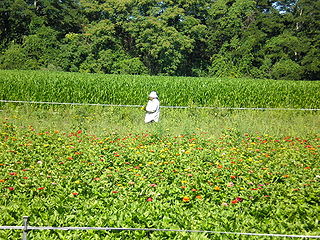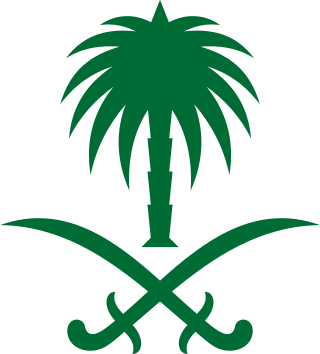
The United Arab Emirates is a high-income developing market economy. The UAE's economy is the 4th largest in the Middle East, with a gross domestic product (GDP) of US$415 billion in 2021-2023.

Foreign workers or guest workers are people who work in a country other than one of which they are a citizen. Some foreign workers use a guest worker program in a country with more preferred job prospects than in their home country. Guest workers are often either sent or invited to work outside their home country or have acquired a job before leaving their home country, whereas migrant workers often leave their home country without a specific job in prospect.
Labor rights or workers' rights are both legal rights and human rights relating to labor relations between workers and employers. These rights are codified in national and international labor and employment law. In general, these rights influence working conditions in the relations of employment. One of the most prominent is the right to freedom of association, otherwise known as the right to organize. Workers organized in trade unions exercise the right to collective bargaining to improve working conditions.

A migrant worker is a person who migrates within a home country or outside it to pursue work. Migrant workers usually do not have an intention to stay permanently in the country or region in which they work.
Human Rights in the UAE are substantially restricted. The UAE does not have democratically elected institutions and citizens don't have the right to change their government or form political parties. Activists and academics who criticize the government are detained and imprisoned, and their families are often harassed by the state security apparatus. There are reports of forced disappearances of foreign nationals and Emirati citizens, who have been abducted, detained and tortured in undisclosed locations, and denied the right to a speedy trial and access to counsel during investigations by the UAE government. Human Rights Watch states that Emirati laws maintain capital punishment and discriminate against women, migrants and LGBT individuals.

Human rights in Dubai are based on the Constitution and enacted law, which promise equitable treatment of all people, regardless of race, nationality or social status, per Article 25 of the Constitution of the United Arab Emirates. Despite this, Freedom House has stated: "Extreme forms of self-censorship are widely practiced, particularly regarding issues such as local politics, culture, religion, or any other subject the government deems politically or culturally sensitive. The Dubai Media Free Zone (DMFZ), an area in which foreign media outlets produce print and broadcast material intended for foreign audiences, is the only arena where the press operates with relative freedom."
According to Human Rights Watch, there is substantial discrimination against women in the United Arab Emirates. The status of women has improved over the years. UAE performs better on metrics of gender equality than many other states in the Gulf region, and it has been making reforms to protect women's rights and empower women in different sectors. Critics describe some of these reforms as window dressing.
Filipinos in the United Arab Emirates are migrants or descendants of the Filipinos living in the United Arab Emirates. 679,819 Filipinos live in the UAE, of which 450,000 live in Dubai, and they form 6.1% of the whole UAE population, and they form 21.3% of the population of Dubai. Dubai is home to the largest population of Filipinos in the UAE, followed by Abu Dhabi and Al Ain. In 2007, Filipinos in the UAE sent more than US$500 million in remittances back to the Philippines.

Bangladeshis in the Middle East, form the largest part of the worldwide Bangladeshi diaspora. Although Bangladesh only came into existence in 1971, the land of East Bengal which is today Bangladesh has strong ties to the Middle East. Out of the 13 Million Bangladeshis abroad approximately 8 million live within the Middle East, with 2.5 million in Saudi Arabia and a 1 million of them in the United Arab Emirates. Bangladeshis who come to the Middle East are primarily guest workers or day labourers. Bangladesh is one of the largest labour suppliers to Saudi Arabia. In 2007, Bangladeshi workers obtained the biggest share, with 23.50 per cent of the 1.5 million Saudi Arabia visas issued.
The state of human rights in Qatar is a concern for several non-governmental organisations, such as the Human Rights Watch (HRW), which reported in 2012 that hundreds of thousands of mostly South Asian migrant workers in construction in Qatar risk serious exploitation and abuse, sometimes amounting to forced labour. Qatar is an authoritarian and de facto absolute monarchy under the House of Thani. Qatari law also does not permit the establishment of political bodies or trade unions. Awareness of human rights abuses in Qatar grew internationally after Qatar's controversial selection to stage the 2022 FIFA World Cup.

The labour force of the United Arab Emirates is primarily made up of foreign temporary workers, most of whom come from the Indian subcontinent and other parts of the Arab World and Asia. There is a sizeable number of Westerners, the majority of them being British and Americans.
Qatar is a transit and destination country for men and women subjected to trafficking in persons, specifically forced labor and, to a much lesser extent, forced prostitution. Men and women from Nepal, India, Pakistan, Bangladesh, the Philippines, Indonesia, Vietnam, Sri Lanka, Ethiopia, Sudan, Thailand, Egypt, Syria, Jordan, and China voluntarily travel to Qatar as laborers and domestic servants, but some subsequently face conditions indicative of involuntary servitude. These conditions include threats of serious physical or financial harm; job switching; the withholding of pay; charging workers for benefits for which the employer is responsible; restrictions on freedom of movement, including the confiscation of passports and travel documents and the withholding of exit permits; arbitrary detention; threats of legal action and deportation; false charges; and physical, mental, and sexual abuse. In some cases, arriving migrant workers have found that the terms of employment in Qatar are wholly different from those they agreed to in their home countries. Individuals employed as domestic servants are particularly vulnerable to trafficking since they are not covered under the provisions of the labor law. A small number of foreign workers transit Qatar and are forced to work on farms in Saudi Arabia. Qatar is also a destination for women who migrate and become involved in prostitution, but the extent to which these women are subjected to forced prostitution is unknown. Children have been used in Qatar and other Gulf countries as camel jockies. Most children are trafficked from Africa and South Asia. This practice has ceased in most areas though. Workers have been forced to work in bad conditions; their salaries are sometimes withheld.

The kafala system is a system used to monitor migrant laborers, working primarily in the construction and domestic sectors in Gulf Cooperation Council member states and a few neighboring countries, namely Qatar, Bahrain, Kuwait, Lebanon, Oman, Saudi Arabia and the United Arab Emirates.

Foreign workers in Saudi Arabia, estimated to number about 9 million as of April 2013, began migrating to the country soon after oil was discovered in the late 1930s. Initially, the main influx was composed of Arab and Western technical, professional and administrative personnel, but subsequently substantial numbers came from Southeast Asia.

Lebanon has gone through many stages in its absorption of migrant workers, both before and after the Lebanese Civil War. This development has led to multiple problems regarding integration in Lebanese society. The ambiguity of the Kafala system in Lebanon has resulted in migrant domestic workers facing many legal issues and violations to their basic human rights. The government has largely been inactive and ineffective in implementing laws to protect migrant domestic workers but has attempted to manage the situation but to little avail.
Migrant workers in the Gulf Cooperation Council region involves the prevalence of migrant workers in the Kingdom of Bahrain, the State of Kuwait, the Sultanate of Oman, the State of Qatar, the Kingdom of Saudi Arabia and the United Arab Emirates (UAE). Together, these six countries form the Gulf Cooperation Council (GCC), established in 1981. The GCC cooperates on issues related to economy and politics, and the subject of migrant workers constitutes a substantial part of the council's collaboration. All of the GCC countries are dependent on migrant labor to bolster and stimulate economic growth and development, as the GCC countries possess an abundance of capital while the domestic labor capacity is low. Although migrant workers in the Persian Gulf region amount to no more than 10% of all migrants worldwide, they constitute a significant part of the populations of their host countries.

For most of its history, Qatar practiced slavery until its abolition in 1952. Many members of the Afro-Arabian minority are descendants of the former slaves. Chattel slavery was succeeded by the Kafala system. The kafala system has been abolished in Qatar since December 2016. However, concerns still remain about workers' rights and employers retaining considerable power over workers.

The treatment of South Asian labourers in the Gulf Cooperation Council (GCC) region is an ongoing issue between members of the South Asian Association for Regional Cooperation (SAARC) nations and the wealthy oil-rich Gulf Cooperation Council. The current large number of migrants from South Asia to the Persian Gulf began in the 1960s, when the oil boom in the Gulf Arab countries resulted in migrant labourers. This further increased with the development of large mega-cities. With the growth of megacities of Dubai, Doha and Riyadh, the need for construction labourers grew. Migrants from Bhutan, Nepal,, Pakistan, India, Sri Lanka, Bangladesh, and Maldives were contracted to develop the mushrooming skyscrapers. Many of these migrants were brought into the GCC under the kafala system, a sponsor-based system used in the GCC, which is seen by many human rights groups as highly exploitative, since their passports are confiscated and they are forced to work in low-level conditions, within cramped living quarters, for a low salary, and sometimes even without their due pay; when exploitation is brought up or exposed by media or the labourers, their employers are rarely punished.

Slavery existed in the Trucial States (1892–1971), which later formed the United Arab Emirates. The Trucial States consisted of the Sheikdoms Dubai, Abu Dhabi, Sharjah, Ajman, Umm Al Quwain, Fujairah, and Ras Al Khaimah. The region was mainly supplied with enslaved people from the Indian Ocean slave trade, but humans were also trafficked to the area from Hejaz, Oman and Persia. Slaves were used in the famous pearl fish industry and later in the oil industry, as well as sex slaves and domestic servants. Many members of the Afro-Arabian minority are descendants of the former slaves.

Open slavery existed in Bahrain until the 1930s. Slavery was formally abolished in Bahrain in 1937. Slavery ended earlier in Bahrain than in any other Gulf state, with the exception of Iran and Iraq. Many members of the Afro-Arabian minority are descendants of the former slaves. Slavery of people from Africa and East Asia was succeeded by the modern Kafala system of poor workers from the same region were slaves had previously been imported.












